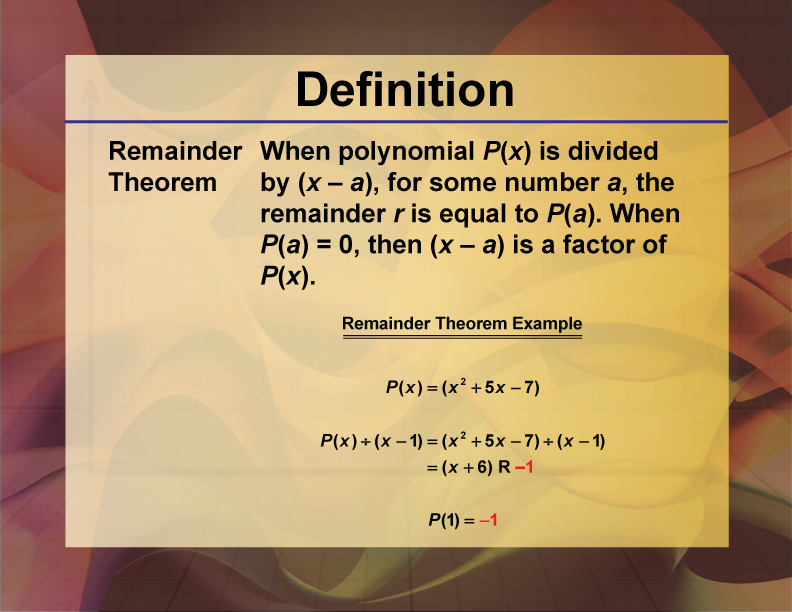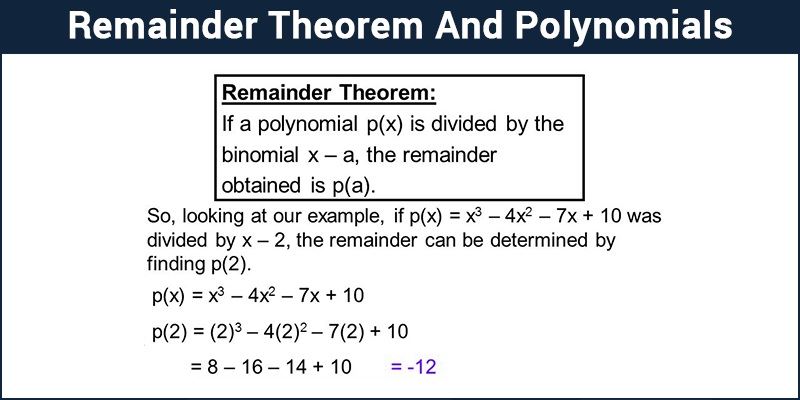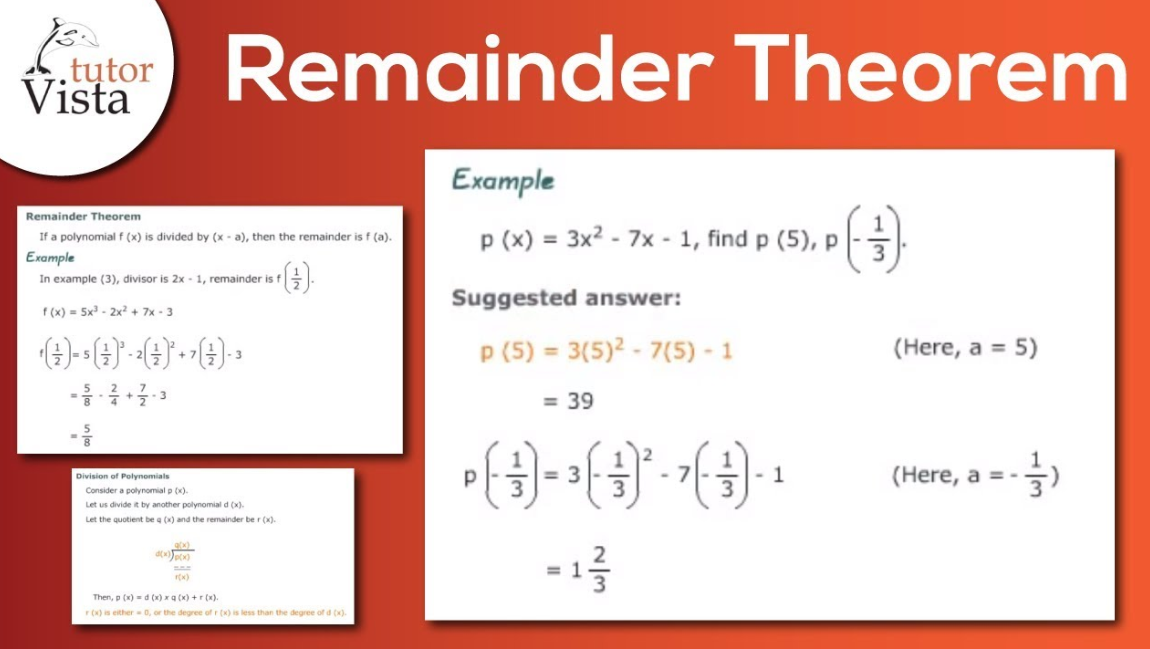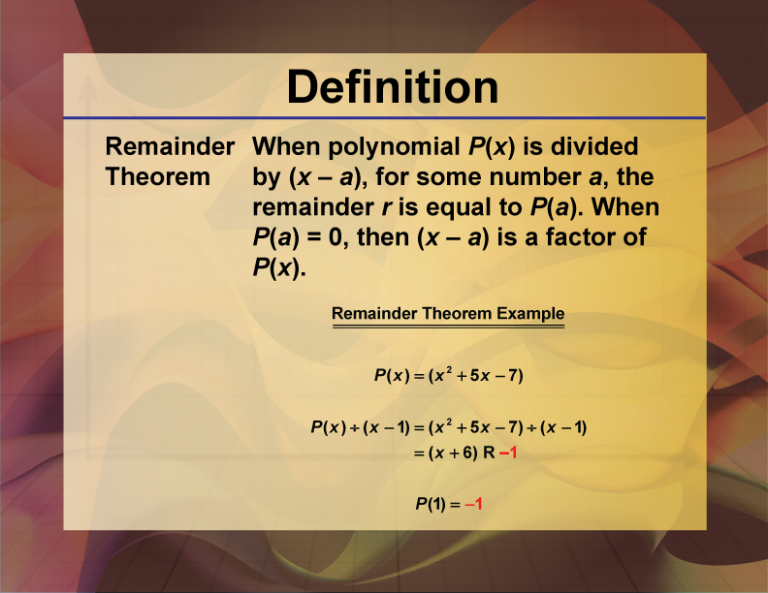The remaining theorem is a formula for calculating the remainder when dividing a polynomial by a linear polynomial. The amount of items left over after dividing a specific number of things into groups with an equal number of things in each group is known as the remnant. After division, it is anything that “remains.” Let us first study the remainder theorem.
Everyone enjoys finding a shortcut, whether it is for driving directions or another sort of tedious work. Seeing a faster and more efficient method to the same endpoint makes you feel good because you’ve probably saved time, effort, and money. The remainder theorem is one of the more effective of these shortcuts in mathematics. The Chinese remainder theorem is a unique solution to simultaneous linear congruences with coprime moduli. In its most basic version, the Chinese remainder theorem will identify a number p that, when divided by certain specified divisors, leaves provided remainders.
If you wanted to know more about Remainder Theorem, you’re welcome here. Read on as we explore the facts about this topic.

Remainder Theorem Definition
The following is the remaining theorem: The remainder is provided by r = a when a polynomial an (x) is divided by a linear polynomial b(x) whose zero is x = k. (k). The remainder theorem allows us to determine the remaining of dividing any polynomial by a linear polynomial without actually performing the division algorithm steps.
The Remainder Theorem is a method to Euclidean polynomial division. According to this theorem, dividing a polynomial P(x) by a factor ( x – a) that isn’t a polynomial element yields a smaller polynomial and a remainder. This obtained residual is really a value of P(x) when x = a, more particularly P (a). A is thus the divisor of P(x) if and P(a) = 0. It is used to factor polynomials of any degree in an attractive way.
Factor theorem
The Factor Theorem is commonly used to factor and determine the roots of polynomial equations. It is the opposite of the remainder theorem. Problems are handled by using synthetic division and then checking for a zero remainder.
When p(x) = 0, y-x is a polynomial factor. Or, to put it another way, However, y-x is a polynomial factor. As a result, p(x) = 0.

The Remainder Theorem Formula
Consider a general scenario to see how the remainder theorem works. Let an (x) represent the dividend polynomial and b(x) represent the linear divisor polynomial. We’ll call the quotient q(x) and the constant remainder r. As a result,
a(x) Equals b(x), q(x), and r
Let k represent the zero of the linear polynomial b(x). As a result, b(k) = 0. When we substitute x for k in the starred relation above, we get a(k) = b(k) q(k) + r.
This is permissible since the starred connection remains true for all values of x. It is, in reality, a polynomial identity. Because b(k)=0, we have a(k)=r. In other words, when x equals k, the remainder equals the value of an (x). That’s exactly what we discovered! The remainder theorem is exactly what it sounds like: When a polynomial an (x) is divided by a linear polynomial b(x), the remainder is given by r=a(x) (k). Consider the following example with two polynomials to show how it works in the case of polynomials:
a(x) : 6×4 – x3 + 2×2 – 7x + 2
b(x) : 2x + 3
When polynomials are divided, the quotient polynomial and the remainder are:
r = 203/4 q(x) = 3×3 – 5×2 + 17/2 x – 65/4
In this example, we estimated the remainder to be r = 203/4. Now consider what occurs when we evaluate a(x) for x equal to the zero of b(x), x = -3/2.
Notes
The remainder is provided by r = a when a polynomial a(x) is divided by a linear polynomial b(x) whose zero is x = k. (k)
p(x) = (x-c)q(x) + r is the remainder theorem formula (x).
Dividend = (Divisor Quotient) + remainder is the basic formula for calculating the division.

The Remainder Theorem Examples with Answer
Example 1:
Casey is attempting to solve a polynomial expression. Assist her in calculating the residual when p(x):3x5x4+x34x2+2 is divided by q(x):x1.
Answer
We will use the remainder theorem: we will substitute the zero of q(x) into the polynomial p(x) to find the remainder r:
r = p(1)
= 3(1)5 – (1)4 + (1)3 – 4(1)2 + 2
= 3 – 1 + 1 – 4 + 2
= 1
Example 2:
Find the remainder when
t3–2t2+t+1
t3–2t2+t+1 is divided by t – 1.
Solution: Here,
p(t) = t – 2t +t+1
p(t)=t3–2t2+t+1
Answer:The zero of t – 1 is 1.
∴ p (1) = (1)3 – 2(1)2 + 1 + 1= 2
By the Remainder Theorem, 2 is the remainder when
t3–2 t2+t+1
t3–2t2+t+1
is divided by t – 1.
Example 3:
Determine that x = 1 is a root of P(x)
Answer: It implies that x = 1 is a root of P(x) and (x – 1) is a factor of P(x).
Then, if we divide P(x) by (x – 1) synthetically, we obtain a new smaller polynomial with a remainder of zero.
Example 4:
Find the remainder when 376 is divided by 35.
Answer: In this case, m = 3, a = 76, and n = 35.
In the preceding example, we discovered the totient function of 35, which equals 24.
The remainder of 76(35 ) = 76/24 = 4
The remaining power is 4, which when divided by 35 yields the remainder.
which equals 11
As a result, the remaining is 11.
Example 5:
Divide 3×3 + x2 + 2x + 5 by x + 1.
Answer: From the given,
Dividend = p(x) = 3×3 + x2 + 2x + 5
Divisor = g(x) = (x + 1)
Here, quotient = q(x) = 3×2 – 2x + 4
Remainder = r(x) = 1
Verification:
Given, the divisor is (x + 1), i.e. it is a factor of the given polynomial p(x).
Let x + 1 = 0
x = -1
Substituting x = -1 in p(x),
p(-1) = 3(-1)3 + (-1)2 + 2(-1) + 5
= 3(-1) + 1 – 2 + 5
= -3 + 4
= 1
Remainder = Value of p(x) at x = -1.
Hence proved the remainder theorem.
Alternatively,
p(x) = (x – a)·q(x) + r
Observe what happens when we have x equal to a:
p(a) = (a – a)·q(a) + r
Substituting the values,
p(-1) = [-1 – (-1)]·q(-1) + (-1)
p(-1) = 0.q(-1) – 1
In this case,
p(-1) = -1
p(-1) = remainder
Hence proved.
Polynomial Remainder Theorem
- To begin, arrange the polynomials (dividend and divisor) in decreasing degree order.
- When you get the first term of the quotient, divide the first term of the dividend by the first term of the divisor.
- To find the remainder, multiply the divisor by the first term of the quotient and remove this product from the dividend.
- This residual is now also the dividend. Thus the divisor will stay unchanged.
- Rep step one until the degree of the new dividend is less than the degree of the divisor.
The Remainder Theorem Functions
When used with the synthetic division, the remainder theorem is very beneficial. If you recall, a synthetic division is an alternative approach to the long division for rapidly and simply dividing polynomials. Also, keep in mind that the value in the bottom row of the last column on the right is the remainder in the synthetic division. Therefore, synthetic division can be present to evaluate a polynomial for a proper value rather than putting in a value and utilizing the order of operations.
Furthermore, we may use synthetic division and the remainder theorem to determine if a value of a function is a zero. Hopefully, you recall that a zero of a function is any point c where f(c) = 0. As a result, if you discover a zero-residual after performing synthetic division, the number specified in front, referred to as an in the definition above, evaluates to zero, or f(a) = 0. It should be popular that long division can be there instead of synthetic division. However, the synthetic division is usually always faster and easier.
Chinese Remainder Theorem
The Chinese remainder theorem in number theory asserts that if one knows the remainder of the Euclidean division of an integer n by multiple integers. We may therefore determine the remainder of n dividing by the product of these numbers uniquely. This is assuming that the divisors are pairwise coprime. The theory was first stated in the third century AD by the Chinese mathematician Sunzi in Sunzi Suanjing.
Between the modulo N ring of numbers and the direct product of the rings of integers, This indicates that while doing a series of mathematical operations. One can do the identical computation separately in each and then apply the isomorphism to obtain the result (from right to left). If N and the number of operations are big, this may be significantly quicker than the direct computation. This is often there as multi-modular computation. This is valid for linear algebra over integers or rational numbers.
Read Also: Genotype vs. Phenotype Lesson for Kids: Definitions & Examples
The Chinese remainder theorem is extensively useful in big integer computation. This allows for the replacement of computation for which a constraint on the size of the result is popular as numerous identical computations on tiny integers.
Chinese Remainder Theorem Calculator
We may examine the Chinese remainder theorem using the chinese remainder theorem calculator. In essence, the assertion states that finding a unique solution to a collection of remaining equations is always achievable. This is also known as congruences. It is strongly connected to the Euclidean algorithm and the identity of Bézout. These are popular in instances to prove the Chinese remainder theorem.
The last island in this enormous sea of unintelligible symbols is number theory. It is a branch of mathematics concerned with integers, or numbers such as 0, 1, 42, or -273. That’s correct, it doesn’t bother with fractions at all! Doesn’t it appear to be a really tight field? They must have figured out everything by now, don’t you think?
We recommend that you look up the Riemann conjecture to discover how far mathematicians can go when left to their own devices.



